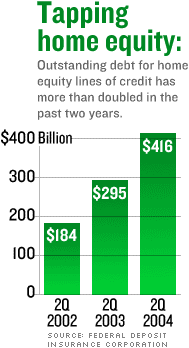SALEM, Ore. (CNN/Money) – It should come as no surprise that outstanding debt for home equity lines of credit has grown over the last year. These loans, which allow you to borrow against the equity in your home any time, for any purpose just by writing a check, are cheap, convenient and widely available.

Still, the numbers are staggering.
According to Federal Deposit Insurance Corporation, the amount of outstanding debt in the form of home equity lines of credit, or HELOCs, was recently $416 billion at the end of the second quarter, up 41 percent from the same time in 2003. Meanwhile, homeowners still have a lot of equity to burn. Unused credit available recently totaled $435 billion, up 52 percent from a year ago.
"Homeowners have been pretty aggressive in tapping their home equity," said Richard A. Brown, chief economist for the FDIC. In 2003 alone, they tapped more than $300 billion of home equity via lines of credit and cash out refinancing, he said, or about 4 percent of personal income. "That's a big number."
In 2002 and 2003, "cash out" refinancing -- or borrowing more than the balance of the mortgage -- was a popular way to access home equity. During the second quarter of 2004, for example, 39 percent of all Freddie Mac-owned loans that were refinanced resulted in mortgage balances that were at least 5 percent more than the previous balance.
But with refinancing activity down 75 percent this year, said Brown, lenders have been promoting HELOCs. "Some lenders have even begun to impose fees for people who don't use their credit," said Brown.
The average line of credit available in 2003 was about $69,500 according to the Consumer Bankers Association, up from $55,000 the previous year. On average, homeowners tapped their line of credit 3.7 times last year, taking out $13,142 each time.
The FDIC says that historically banks have not had problems with these loans, but given the rapid growth of these loans "its on our radar screen."
"We're in a transition toward higher interest rates and possibly a leveling off in home prices," said Brown. "The real question we're asking is, can the models account for changes in the macro environment?"
A great deal, when used prudently
Over the past two years, household and consumer debt has increased by $1.7 trillion to $9.1 trillion, ith mortgage debt accounting for 90 percent of that increase.

Home equity lines of credit, which are tied to the prime rate, are more expensive than they were a year ago. In fact, homeowners are likely to see their rates go up on their next statement – reflecting the Federal Reserve Board's most recent quarter-point increase.
"Things are definitely getting more expensive," said Keith Gumbinger, vice president of HSH Associates, which tracks interest rates. "The current average for a line of credit is 5.26 percent, and it's likely to be higher as lenders adjust their rates to account for the Fed hike."
Of course, rates for home equity lines of credit are still significantly lower than home equity loans, which have a fixed rate and fixed repayment schedule. Recently rates on these loans averaged 7.08 percent, according to Gumbinger.
And, as many homeowners have discovered, using a home equity line as part of a down payment on a new home is still generally a better bet than paying private mortgage insurance, which is required if your first mortgage is more than 80 percent of the sale price.
Unlike interest paid on car loans and credit cards, interest on home equity lines and loans is tax deductible (unless you're subject to the alternative minimum tax, in which case you can only deduct interest on borrowing related to the home).
|
 |  | Expense |  | Percent* |  | Home improvement | 38.1 |  | Debt consolidation | 31.9 |  | Home purchase | 4.6 |  | Auto purchase | 4.3 |  | College tuition | 2.9 |  | Small business | 2.2 |
|  |  |
| *Percents don't add up to 100. | | Source: LendingTree survery in June 2004 |
|
"There's no way for consumers to borrow more cheaply," he added.
While there's no question that home equity lines are a good deal right now, there's also no question that they demand quite a bit of self-restraint. Remember, there is no set repayment schedule, and minimum payments are typically no more than the monthly interest on the loan.
"The biggest risk is consumers who use it to pay off consumer debt then turn around and run up consumer debt again," said Ed Powell, chief consumer officer for the LendingTree, which projects that 23.5 percent of its customers will have secured a HELOC or loan by the end of this year.
Another risk is that borrowers will take their time paying off that debt by transferring the balance of, say, a five-year car loan.
"A smart consumer would continue to make the exact same payments as you did before," he said. Or, at least pay enough each month to make sure your debt doesn't outlast the car.
Risk number three is being overly optimistic about the value of your home. The amount of home equity available to you has likely increased along with your home's value. Think twice before borrowing against unrealized gains.
Just because you can max out on your home equity doesn't mean you should.

|